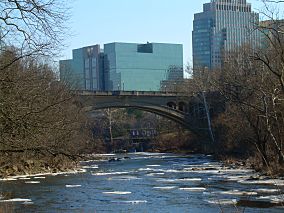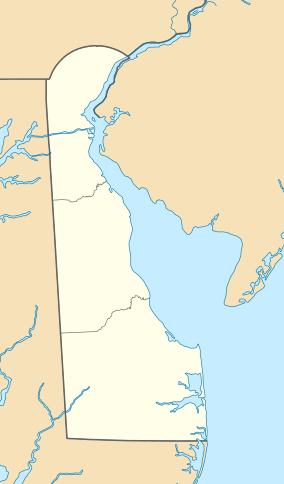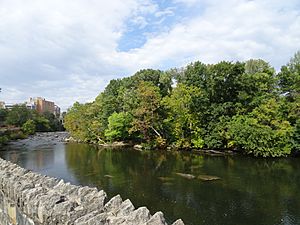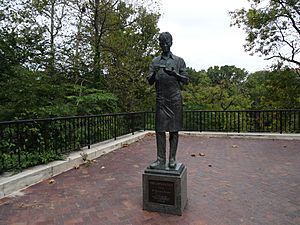Wilmington State Parks facts for kids
Quick facts for kids Wilmington State Parks |
|
|---|---|

Brandywine Creek in Brandywine Park near downtown Wilmington looking downstream.
|
|
| Location | New Castle, Delaware, United States |
| Elevation | 100 ft (30 m) |
| Established | 1998 |
| Named for | Wilmington, Delaware |
| Governing body | Delaware Department of Natural Resources and Environmental Control |
| Website | Wilmington State Parks |
Wilmington State Parks is a cool state park located in Wilmington, Delaware. It's open all year long! The park covers about 345 acres of land. Most of it is found along the beautiful Brandywine Creek.
This state park is actually a collection of smaller parks. They are all managed together as one big unit. Even though the city of Wilmington owns most of the land, the park is run by the Delaware Division of Parks and Recreation. This group is part of the state's Department of Natural Resources and Environmental Control. The state park was officially created in 1998. However, some of the individual parks are much older. The oldest one started way back in 1886!
You can find many statues and memorials in Wilmington State Parks. These include memorials for wars and statues of important people from Wilmington's past. For example, there are statues for Rear Admiral Samuel Francis Du Pont and U.S. Secretary of State Thomas F. Bayard. You can also see a memorial for President William McKinley. There's even a special bridge for George Washington. He once reviewed his troops nearby during the Revolutionary War.
It's free to enter most parts of the parks. The only place you might need to pay is to get into the zoo.
Contents
Exploring Wilmington State Parks
Wilmington State Parks is made up of four smaller parks. Three of them are located along the Brandywine Creek. They are all connected to each other. These are Brandywine Park, Rockford Park, and H. Fletcher Brown Park. The fourth park is called the Hobbs Tract. It's about four miles away in Greenville.
Brandywine Park: The Oldest Gem
Brandywine Park is the oldest park in Wilmington. It was first created in 1886. A person named William Poole Bancroft helped make it happen. He was a leader in industry and loved nature. He convinced the Delaware government to create a special group for parks. A famous landscape architect, Frederick Law Olmsted, helped design the park. He loved the land along the Brandywine Creek. He thought it was the perfect spot for a park.
This park is about 178 acres big. It stretches across both sides of the Brandywine Creek. Much of the park has natural areas and open spaces. You can find walking trails and amazing views of the creek and woods. The open areas have two beautiful gardens. One is a rose garden, and the other is a cherry blossom garden. The Brandywine Zoo opened in 1904. It now covers 12 acres of the park. Brandywine Park also has fun places for sports. These include playgrounds, athletic fields, and Baynard Stadium.
There's a half-mile road called Kentmere Parkway. It was designed to connect Brandywine Park to Rockford Park. This road was built in 1891. It has a wide, tree-lined area in the middle.
Rockford Park: Home of the Tower
Rockford Park started in 1889 and is 104 acres. William Poole Bancroft and his brother, Samuel, gave the first 59 acres of land. Most of the park has grassy lawns. These lawns gently slope up to a big hill overlooking the Brandywine.
At the top of this hill stands Rockford Tower. It's one of Wilmington's most famous landmarks. This stone tower is 115 feet tall. It was built between 1899 and 1901. The tower is used for water storage. It also has an observation deck at the top. From there, you can see amazing 360-degree views of the park and Wilmington city. The tower is right across the river from the DuPont Experimental Station. This was once a place where old factories operated. The tower is now open to visitors during certain times of the year.
H. Fletcher Brown Park: A Scenic Spot
H. Fletcher Brown Park is the smallest of the Wilmington State Parks. It is located a little bit downstream from Brandywine Park. This park is on the site where an old school used to be. The park offers a great view of the Brandywine Creek. You can also see its historic millrace. This millrace once helped power local factories. Now, it helps supply Wilmington's drinking water.
The park is named after Harry Fletcher Brown. He was a smart chemist and helped many charities. He worked for the DuPont Company. He also helped create new types of gunpowder that were important in World War I. There is a statue of Harry Fletcher Brown in the park. It was made by the sculptor Charles Parks.
Hobbs Tract: A Natural Retreat
The Hobbs Tract covers 62 acres of land. It is next to Valley Garden Park. This area used to be a summer home for U.S. Senator T. Coleman du Pont. The city of Wilmington owns the main part of Valley Garden Park. However, the state of Delaware bought the Hobbs Tract in 2004. This land used to be part of a farm owned by Patricia Hobbs. The state also owns a special agreement to protect 12 more acres of the farm.
Former Parks: What Changed?
When Wilmington State Parks was created in 1998, it included a park called Alapocas Woods. This park started in 1910. It was formed from land given by William Poole Bancroft and Alfred I. du Pont. They wanted to create a new public park. Alapocas Woods was located along the Brandywine Creek. It was across from Rockford Park and just north of Brandywine Park.
In 2002, Alapocas Woods became much bigger. It was then made into its own separate state park, called Alapocas Run State Park. It is still connected to Wilmington State Parks. This connection is through the Northern Delaware Greenway Trail. This trail is 10.4 miles long. It runs through Alapocas Run and into Brandywine Park.
Nearby State Parks to Explore
There are many other state parks close to Wilmington State Parks. Here are some of them within 30 miles (48 km):
- Alapocas Run State Park (New Castle County)
- Auburn Valley State Park (New Castle County)
- Bellevue State Park (New Castle County)
- Brandywine Creek State Park (New Castle County)
- Fort Delaware State Park (New Castle County)
- Fort DuPont State Park (New Castle County)
- Fort Mott State Park (New Jersey)
- Fort Washington State Park (Pennsylvania)
- Fox Point State Park (New Castle County)
- Lums Pond State Park (New Castle County)
- Marsh Creek State Park (Pennsylvania)
- Norristown Farm Park (Pennsylvania)
- Parvin State Park (New Jersey)
- Ridley Creek State Park (Pennsylvania)
- White Clay Creek Preserve (Pennsylvania)
- White Clay Creek State Park (New Castle County)





